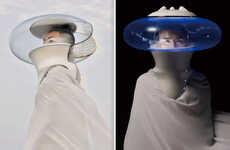
The Amphibio Functions Like a Set of 3D-Printed Gills
Justin Lam — July 17, 2018 — Art & Design
Designed by Jun Kamei, the Amphibio is a two-part 3D-printed accessory that functions as an amphibious garment to help humans survive when sea levels eventually submerge the earth. Functioning like a set of gills, this amphibious garment pulls oxygen from water and releases carbon dioxide back into the water. While the Amphibio prototype doesn't produce enough oxygen to support human survival, it has been successful in producing oxygen from water.
Kamei was inspired to design this item in response to rising sea levels and has called the amphibious garment an essential part of living in the future. Instead of focusing on the negative ideas of a flooded world, Kamei designed the Amphibio with an optimistic view of the future. HIs device would allow humanity to continue living in a flooded world and would ensure humans could explore the oceans around them.
Kamei was inspired to design this item in response to rising sea levels and has called the amphibious garment an essential part of living in the future. Instead of focusing on the negative ideas of a flooded world, Kamei designed the Amphibio with an optimistic view of the future. HIs device would allow humanity to continue living in a flooded world and would ensure humans could explore the oceans around them.
Trend Themes
1. Amphibious Apparel - Developing 3D-printed garments that function as amphibious accessories can create a new market for survival gear that can adapt to climate change.
2. Underwater Oxygen Generation - Investing in underwater 3D-printing technology that generates oxygen from water to support human survival and exploration can lead to innovations in ocean exploration and aquaculture.
3. Sustainable Futuristic Designs - Designing sustainable technologies that address global challenges, such as rising sea levels, can offer new business opportunities that meet consumer demand for eco-friendly products.
Industry Implications
1. Outdoor Recreation - Creating new materials and technologies for amphibious apparel can disrupt the outdoor recreation industry by expanding outdoor activities to include water and providing innovative survival gear.
2. Marine Exploration - Developing 3D-printed underwater accessories that generate oxygen from water can disrupt marine exploration by enabling longer underwater stays for divers and researchers.
3. Eco-friendly Fashion - Incorporating 3D-printing technology into sustainable fashion designs that address global challenges can disrupt the fashion industry by providing innovative and eco-friendly products.
1.8
Score
Popularity
Activity
Freshness























